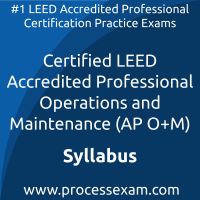 To achieve the professional designation of USGBC LEED Accredited Professional Operations and Maintenance from the USGBC, candidates must clear the AP O+M Exam with the minimum cut-off score. For those who wish to pass the USGBC LEED Accredited Professional Operations and Maintenance certification exam with good percentage, please take a look at the following reference document detailing what should be included in USGBC LEED AP O+M Exam preparation.
To achieve the professional designation of USGBC LEED Accredited Professional Operations and Maintenance from the USGBC, candidates must clear the AP O+M Exam with the minimum cut-off score. For those who wish to pass the USGBC LEED Accredited Professional Operations and Maintenance certification exam with good percentage, please take a look at the following reference document detailing what should be included in USGBC LEED AP O+M Exam preparation.
The USGBC AP O+M Exam Summary, Sample Question Bank and Practice Exam provide the basis for the real Certified LEED Accredited Professional Operations and Maintenance (AP O+M) exam. We have designed these resources to help you get ready to take USGBC LEED Accredited Professional Operations and Maintenance (AP O+M) exam. If you have made the decision to become a certified professional, we suggest you take authorized training and prepare with our online premium USGBC LEED Accredited Professional Operations and Maintenance Practice Exam to achieve the best result.
USGBC AP O+M Exam Summary:
| Exam Name | USGBC LEED Accredited Professional Operations and Maintenance |
| Exam Code | AP O+M |
| Exam Fee |
Combined exam: $550 ($400 for USGBC members)
Specialty only: $350 ($250 for USGBC members)
|
| Exam Duration | 120 Minutes |
| Number of Questions | 100 |
| Passing Score | 170 out of 200 |
| Format | Multiple Choice Questions |
| Schedule Exam | USGBC |
| Sample Questions | USGBC LEED AP O+M Exam Sample Questions and Answers |
| Practice Exam | Certified LEED Accredited Professional Operations and Maintenance (AP O+M) Practice Test |
USGBC LEED Accredited Professional Operations and Maintenance Syllabus Topics:
| Topic | Details |
|---|---|
| LEED Process (12 Questions) |
- LEED interpretations
- LEED system synergies (e.g., energy and EQ; waste management; building operation plan and ventilation calculations) - Project boundary; LEED boundary; property boundary; master site boundary - Prerequisites and/or minimum program requirements for LEED certification - Occupancy requirements (e.g., existing building [building must be fully occupied for 12 continuous months as described in minimum program requirements]; reduced occupancy guidance; 10% exemptions) - Recertification (e.g., initial vs. recertification; performance period; ongoing performance; data tracking) - Review process (e.g., Establishment vs. Performance review; credit statuses; credit responses; review report) - Integrative process (e.g., roles of responsibilities; facilitating collaboration) - Adaptations (e.g., unique compliance paths and/or separate credits for different project types) - Ways to earn innovation credits:
|
| Location and Transportation (5 Questions) |
- Alternative transportation
|
| Sustainable Sites (9 Questions) |
- Site design and development
- Site management practices (e.g., impacts of site management decisions; planning for future site management; site equipment and maintenance materials)
|
| Water Efficiency (13 Questions) |
- Outdoor water use reduction: irrigation demand (e.g., landscape water requirement; irrigation system efficiency; calculated water budget; native and adaptive species)
- Cooling tower water use: water conservation techniques (e.g., cycles of concentration; total dissolved solids; potable water treatment; non-potable water use)
- Water performance management
|
| Energy and Atmosphere (21 Questions) |
- Building loads
- Energy efficiency
- Alternative and renewable energy practices
- Demand response (e.g., grid efficiency and reliability; demand response programs; load shifting)
- Energy performance management:
- Environmental concerns: upstream and downstream impacts (e.g., sources and energy resources [oil, coal, and natural gas]; renewable and nonrenewable resources; chlorofluorocarbons (CFCs) and other refrigerants; stratospheric ozone layer depletion)
|
| Materials and Resources (10 Questions) |
- Life-cycle impacts
- Waste
- Purchasing policies (e.g., environmental preferable purchasing (EPP) policy; ongoing consumables; durable goods; maintenance and renovations; lighting purchases)
|
| Indoor Environmental Quality (15 Questions) |
- Indoor environmental quality
- Lighting: electric lighting quality (e.g., tradeoffs [color, efficiency]; surface reflectance; types of fixtures; project-specific considerations)
- Daylight (e.g., building massing and orientation; glare; illuminance) - Occupant comfort, health, and satisfaction:
|
Both USGBC and veterans who’ve earned multiple certifications maintain that the best preparation for a USGBC AP O+M professional certification exam is practical experience, hands-on training and practice exam. This is the most effective way to gain in-depth understanding of USGBC LEED AP O+M concepts. When you understand techniques, it helps you retain USGBC LEED Accredited Professional Operations and Maintenance knowledge and recall that when needed.
